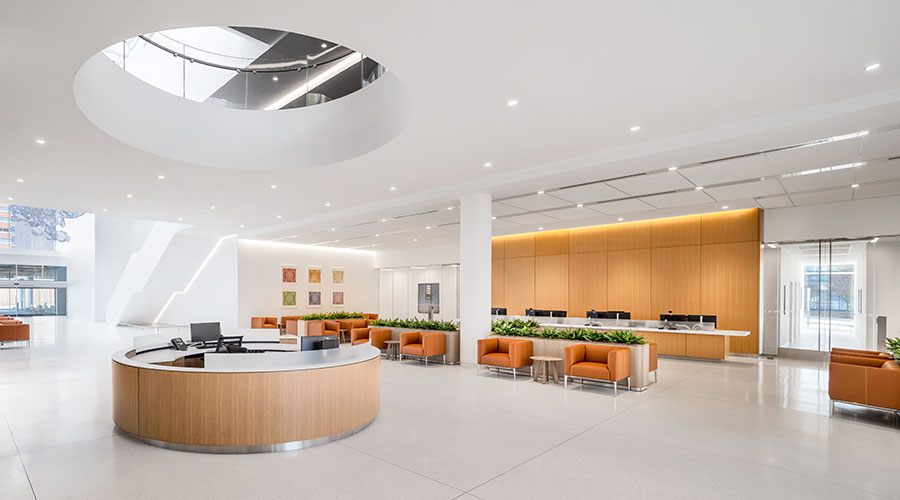Despite a continuing state of flux and uncertainty in the healthcare industry, U.S. healthcare executives are optimistic about the future, according to JLL’s Global Future of Work Survey 2024. Many anticipate growth in their footprint and operations over the next five years, providing opportunities for their facilities teams to grow in size and influence.
U.S. healthcare organizations’ top corporate goals by 2030 include creating new products and services, achieving organizational efficiency and delivering greater community impact. Other high priorities include reducing operating costs, growing revenue, attracting and retaining talent, digitalization and reducing environmental impact.
Facilities leaders can play a meaningful role in helping advance any or all of these priorities, with the right structure and skill sets. The first step is to understand the top trends shaping healthcare real estate strategy today, from addressing new working patterns and embracing artificial intelligence (AI) to finding fresh ways to drive organizational value.
Trend: Shifting work patterns
Some of the future growth in healthcare corporate real estate budgets will be directed toward workplace improvements. Nearly 70 percent of facilities leaders anticipate increased investments in real estate technologies that will boost portfolio, building or workplace performance.
Meanwhile, 65 percent expect more investment in central business district locations that appeal to younger workers. Employee health, wellbeing and workplace experience considerations are also major drivers, as nearly 70 percent of respondents expect to increase spending on employee experience and hospitality services over the next five years.
While pay and benefits remain top priorities for healthcare workers, employers need to look beyond compensation. Leading organizations recognize that the physical workplace can help address the competition for talent and plays a crucial role in the employee experience and employee satisfaction.
An environment that helps healthcare employees thrive and become more productive supports patient outcomes, too. Well-maintained spaces that support caregiver wellbeing reduce stress and fatigue, and those benefits translate into better patient care.
On the administrative side, U.S. healthcare companies are split in allowing worker hybrid flexibility versus requiring in-office presence. Nearly 50 percent of U.S. healthcare organizations are office advocates, requiring administrative employees work on-site five days per week, followed by 40 percent that require three or four in-office days. Eleven percent either require two days per week on site or have no requirements.
By partnering with business leaders and human resources, healthcare facilities departments can define and deliver an evolutionary workplace program that makes the most sense for their organization now while providing flexibility to adapt to changing work patterns later.
Trend: AI and other game-changers
With AI garnering headlines across industries, it is not surprising that two-thirds of healthcare facilities leaders agree that AI could help solve major challenges, and 64 percent say AI will change the way their workforce operates over the next five years. More than two-thirds view technology and AI adoption as critical for enhancing real estate value.
The AI transformation is underway in healthcare corporate real estate, as more than one-half of survey respondents say they have a strategy in place for embedding AI. Already, corporate real estate and facilities management departments at some healthcare organizations find they can harness technology and AI to meet uncertainty with flexibility, such as designing AI-enabled spaces that can adapt and decode space usage.
AI is useful for aggregating facilities and workplace data, as well as for uncovering trends to facilitate faster and better-informed corporate real estate decisions. Data-driven insights can help a hospital quickly change a layout to fit new medical equipment, carve out a training space, create flexible employee workspaces or otherwise optimize use of space — a critical capability in today’s fast-moving healthcare sector.
Trend: Environmental and social considerations
Sustainability has long been important in the healthcare industry. U.S. healthcare organizations are more likely than U.S. organizations in general to pay a premium for facilities with leading health and wellbeing credentials, according to JLL’s research. A growing number of sites feature climate-resilient buildings made with sustainable building materials and equipped with recyclable furniture.
To reach more ambitious sustainability goals down the line, corporate real estate teams should identify incremental milestones along the way. They can secure C-suite buy-in and investment by going beyond traditional key performance indicators to show the extra-financial value created by environmentally responsible investments.
Healthcare facilities teams are also increasingly focused on creating social value. Globally, 84 percent of corporate real estate leaders say their function has a well-defined program to deliver greater community impact. Two-thirds of healthcare facilities departments also are designing workplaces that meet the latest diversity, equity and inclusion requirements, as well as meeting the needs of the multi-generational workforce.
To enhance community impact, corporate real estate and facilities departments can investigate the way workplaces might be used for nonprofit and community events while continuing to innovate in the ways they hire local talent and serve the community.
For insight on how to respond to these trends by 2030, read part two of this article here.
Cheryl Carron is the Americas chief operating officer for JLL’s work dynamics business and president of the firm’s healthcare division.

 Should We Be Testing Toilet Water in Patient Restrooms?
Should We Be Testing Toilet Water in Patient Restrooms? Healthcare Union Petitions for Increased Staff Safety at HCA Florida Hospitals
Healthcare Union Petitions for Increased Staff Safety at HCA Florida Hospitals HGA Announces Completion of the Jeffrey and Patricia Cole Pavilion
HGA Announces Completion of the Jeffrey and Patricia Cole Pavilion Healthcare Facilities Look to Future-Proof Facilities
Healthcare Facilities Look to Future-Proof Facilities Yale New Haven Health Experiences Data Breach
Yale New Haven Health Experiences Data Breach